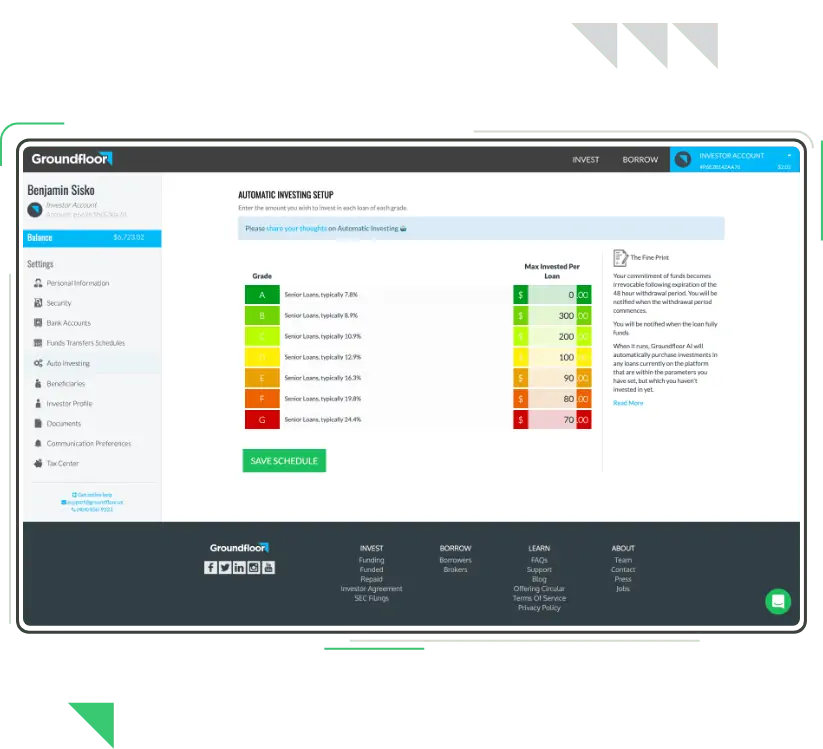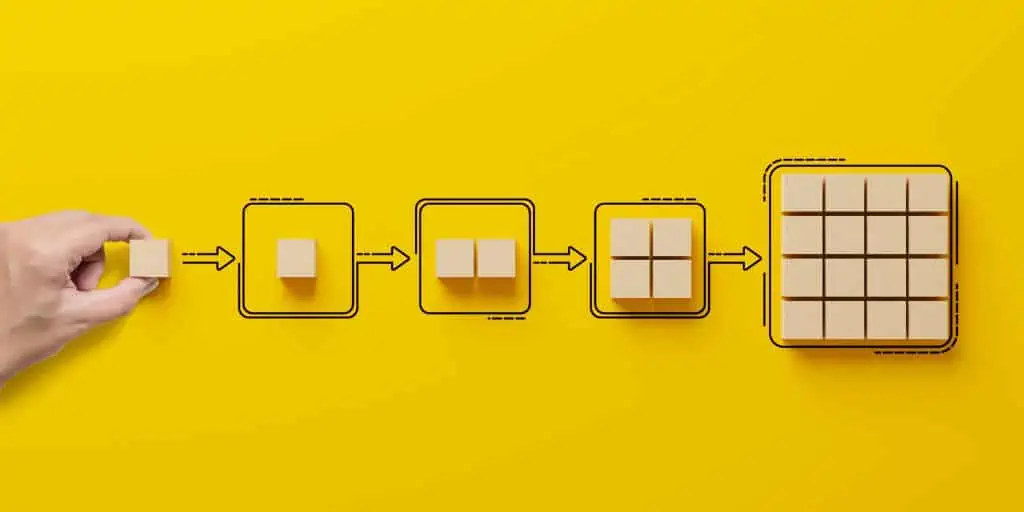
REtipster features products and services we find useful. If you buy something through the links below, we may receive a referral fee, which helps support our work. Learn more.
As real estate crowdfunding platforms go, Groundfloor is one of my favorites.
It pays strong returns without the long-term commitment and requires just $10 to start. Diversification is easy, and the company has a strong track record of paying investors back.
Best of all, Groundfloor is open to everyone, not just wealthy accredited investors.
As you explore real estate crowdfunding options, look at Groundfloor as a strong contender.
Groundfloor Rating
-
Overall Rating
Summary
Groundfloor pays strong returns without the long-term commitment and requires just $10 to start. Diversification is easy, and the company has a strong track record of paying investors back. Best of all, Groundfloor is open to everyone, not just wealthy accredited investors.
As you explore real estate crowdfunding options, look at Groundfloor as a strong contender.
Pros
- Short Term Investing
- Strong Returns
- Transparency in Returns and Performance
- Open to Non-Accredited Investors
- Low Minimum Investment
- Easy Diversification
- Low LTV Loans
- Automated Investing Available
Cons
- Lack of Liquidity
- Higher Risk in Cooling Markets
- Company Not Yet Profitable
What Is Groundfloor?
Groundfloor is a hard money lender, writing short-term loans to real estate investors. Specifically, they provide purchase-rehab loans to both house flippers and BRRR investors.
REtipster does not provide tax, investment, or financial advice. Always seek the help of a licensed financial professional before taking action.
But they don’t have a vault of gold sitting around to fund all these loans. They raise much of the capital from people like you and me.
You choose individual loans to fund, with as little as $10 going toward any single loan.
How Groundfloor Works

Groundfloor ranks these loans by risk, denoted by letter grade. Grade “A” loans come with the lowest risk, and Grade “G” loans are the highest. The higher the risk grade, the higher the interest rate it pays.
All of the interest on the loan goes to capital investors like you. Groundfloor earns revenue on loan points and other closing fees charged to the borrower.
When you fund a loan, you see not only the risk grade and the interest rate it pays but also the remaining loan term (typically between two to 12 months) and a wide range of details about the property and borrower.
Property details include the address, photos, the type of valuation report, the loan amount, the ARV, and the LTV. You can also view information about the borrower, including their experience level, past deal performance, skin in the game, and information about both the legal entity and principal borrower.
When the borrower refinances or sells the property and repays the loan, you get paid back with interest.
Groundfloor Pros
As an investment platform, Groundfloor comes with plenty of advantages. There’s a lot to like.
Short-Term Investing
Groundfloor bucks the trend that every real estate crowdfunding investment has to be long-term. Despite my positive experiences with Fundrise, for example, I don’t love having to leave my money invested for five years or get hit with penalties.
All loans on Groundfloor are short-term renovation loans. You get your money back as soon as the borrower exits the deal and pays back the loan. That usually means months, not years.
Assuming everything goes to plan, of course. Not every investor pays back the loan on time, or at all for that matter. Occasionally, Groundfloor has to foreclose on defaulting borrowers to recover their (your) money.
Still, even in the worst-case scenario, you aren’t looking at a five-year commitment to get involved.
Strong Returns
In my experience with Groundfloor, I’ve earned an average return of around 9.5% each year. That’s in line with their average all-time return of around 10% and their average 2021 return of 9.45%.
From January through July 2022 (the latest data available at this writing), they’ve returned an average of 9.91%.
Those numbers may not get your blood pumping like a dog in heat, but they’re nothing to scoff at. They’re in line with average stock market returns, except without the wild mood swings and volatility.
Transparency in Returns and Performance
Groundfloor wins top marks for transparency.
You earn the loan interest rate, period. They don’t take any fees out of your returns. Instead, the borrower pays their fees through points and closing costs. Compare this fee and return the structure to HappyNest, with its fee information buried in the legalese of their SEC circular.
I also like that Groundfloor publishes monthly performance reports on how many loans they funded, how many loans were repaid, and the interest rates of those loans. On the rare occasion that I’ve contacted Groundfloor to ask for more information about their performance, they’ve quickly responded and supplied it.
Open to Non-Accredited Investors
Many real estate crowdfunding platforms only allow accredited investors to participate. It makes for easier regulation on their part, but it leaves most Americans unable to invest.
Groundfloor lets anyone invest, with minimal cash to boot.
Low Minimum Investment
Not many investments let you get started with $10.
Groundfloor lets you invest as little as $10 in any given loan, removing any excuse that you “can’t afford to invest.” Skip the lattes this week and invest some money in real estate!
Easy Diversification
That low minimum investment in each loan makes it easy to spread your money among many different loans secured by properties all across the country.
I know that a certain small percentage of these loans will default and won’t pay me the full interest promised. So I spread my money among many different loans, knowing a few won’t pay me interest and might even pay me back less than I invested. But most will pay as promised, so the occasional low or negative return will just blend into my average returns each year.
Low LTV Loans
As a hard money lender, Groundfloor underwrites loans at a relatively low percentage of the property value.
They advertise loans to borrowers with up to 90% of the project cost for experienced real estate investors (and less for most borrowers) and up to 70% of the after-repair value (ARV). If the borrower defaults, that leaves plenty of equity for Groundfloor to recover the loan if they take a deed instead of foreclosure or, in the worst-case scenario, foreclose on the property.
In the three years I’ve invested with Groundfloor, I’ve never lost money on loan. The worst that’s happened has been a return on my original investment with no interest.
Automated Investing Available
Groundfloor lets you optionally set up automatic investments, so you don’t have to keep logging into your account to pick loans to fund.
Admittedly, it’s not a very robust automation system. You simply set the amount that you want to invest automatically in each loan grade, as you have funds available.
I’ve set this up in my account, automatically funding $10 into B-, C-, D-, and the rare E-grade loans. I’d like to see more filters and options in the future, such as capping the LTV on loans for automated investing and setting minimum interest rates, but it works well enough.
Groundfloor Cons
Every investment has its downsides, or else investors would flock to it, and suddenly it wouldn’t have to pay high returns anymore.
Keep the following drawbacks in mind as you consider investing in Groundfloor.
Lack of Liquidity
When you invest in a loan on Groundfloor, you commit your money to it until the loan repays. Whenever that might be—there’s no way to pull your money out of a loan early.
Most loans repay on time, or at least close to it. But a significant minority of borrowers don’t sell or refinance their loans on time, and you get your money back later than expected.
That said, Groundfloor recently launched a Stairs pilot program that offers instant liquidity.
You can pull your money out any time, but that liquidity comes at a cost: you earn 4% to 6% interest instead of 7% to 15%. It works similarly to Concreit, where you invest in a pooled fund of loans backed by real estate and can move money in and out at will.
Higher Risk in Cooling Markets
Low-LTV hard money loans don’t come with many risks when housing markets boom at 5% to 20% appreciation.
But when home prices cool off, suddenly those low-LTV loans don’t look quite as bulletproof. Instead of your loan making up 70% to 90% of the property value, it might make up 80% to 100% of the newly cooled value, which doesn’t leave much (if any) leeway should you have to foreclose to recover your money.
Company Not Yet Profitable
Despite raising billions of dollars in hard money loans, Groundfloor has never turned a profit. That should give you pause as you consider investing money through their platform.
Granted, a lien backs your investment against a specific property. Even if Groundfloor goes bankrupt, you’ll still receive your money back when the borrower repays the loan. But a lender in bankruptcy isn’t exactly the steady hand you’d want to handle loans that default.
At some point, Groundfloor will either turn a profit, or their investors will run out of patience and stop funneling money into them.
How Groundfloor Compares
Groundfloor offers high returns on short-term investments—a combination you don’t see very often.
You can potentially earn higher returns through real estate equity platforms like Fundrise, where Seth earned an average return of 14% over five years. But you must leave your money invested long-term, paying the penalty if you withdraw in under five years.
I’ve collected strong dividends from Streitwise, averaging 8.4% over the last few years. But they, too, come with a long-term commitment and early withdrawal fee and have underperformed Groundfloor’s 9.5% to 10% returns.
If you need fast liquidity, try Concreit or Stairs. Neither pays as high returns, but you can pull your money anytime.
Final Thoughts
Overall, Groundfloor stacks up well in transparency, returns, and lack of a long-term investing commitment.
While you don’t directly benefit from real estate appreciation like you would in an equity investment, you can collect strong interest backed by a real property lien. I’ve found Groundfloor to offer moderate-to-high returns with low-to-moderate risk—a ratio I’ll take any day.
The greatest risk with Groundfloor loans lies in a housing market collapse. If we had a 2008-style real estate crisis, with home values falling by double digits and mass foreclosures, many of your Groundfloor loans would lose money. That said, you’d still get something back on your loan investments after Groundfloor forecloses to recover as much of your investment as possible.
Despite housing markets cooling from their overheated pandemic highs, the U.S. still has a housing shortage. I don’t see a real estate market collapse on the horizon, and I feel confident that I’ll get my Groundfloor investments back with strong interest.












